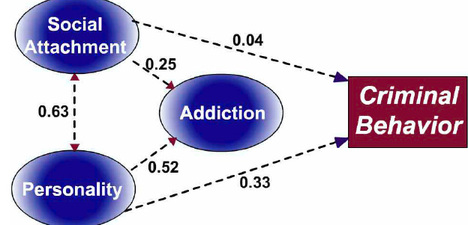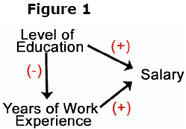The WAGER Vol. 5(4) – Addiction and Criminal Involvement 2: A Model
Last week’s WAGER [WAGER 5(3)] considered research from Germany that Figure 1 examined the prevalence of criminal behavior among problem and non-problem gamblers. This week, we take a closer look at how pathological gambling, gambling and criminal behavior may be related to each other.
LISREL is a computer software program that processes data to provide weights or correlative values for how elements of models relate to each other. For example, suppose we distribute a survey that asks questions about salaries, level of education, and years of work experience. Based on a common sense model, we can hypothesize that level of education and years of work experience relate positively to salary level. Similarly, since a higher level of education means more years in school and less years in the workforce, we expect that level of education will be negatively correlated with work experience. As Figure 1 illustrates, LISREL provides the opportunity to test this model and the relationships among the three central elements of the model. In figure 1, you can see that there is indeed a positive relationship between work experience, level of education and salary.
Meyer and Stadler used the LISREL method to test a model of addiction and crime. In addition to collecting data on gambling status and criminal behavior, they obtained extensive psychosocial information from subjects. From this data, they formulated four primary interactive factors: social attachment, personality, addiction and criminal behavior. They then created a model based on the theoretical assumptions that addiction was related to criminal behavior, and that social attachment and personality were causal in the development of addiction. They also hypothesized that social attachment and personality were related. Meyer and Stadler tested this model using LISREL. The four factors are illustrated in the figure below.

The Meyer and Stadler model explained 40% of the total variance of the target variable "criminal behavior." This finding suggests that they have identified crucial factors that contribute to criminal behavior; however, other important factors remain to be identified if we are to create a more powerful model. Interestingly, social attachment has little association with criminal behavior. One might have expected that there would have been a negative relationship between these two factors: strong social attachments might have led to reduced criminal behavior. Perhaps the authors’ findings reflect the fact that most of the crimes analyzed by the authors (and discussed last week) are non-violent and "white collar." Would the found relationship hold up if the crimes considered were more violent and anti-social? This question provides fodder for future study.
References
Meyer, G. & Stadler, M.A. (1999). Criminal behavior associated with pathological gambling. Journal of Gambling Studies, 15, 29-43.
